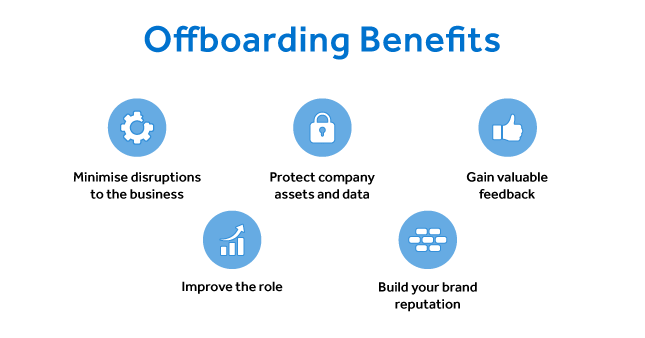
In June this year, The Australian Bureau of Statistics reported that 2.3 million Australians had left or lost a job from Feb 2022 to Feb 2023. This is the highest job mobility rate the country has seen in over a decade. The sheer number of employees parting ways with Australian employers leads to an important question – how effectively are businesses managing their offboarding process?
When an employee leaves a company without undergoing an offboarding process, an opportunity to improve the business walks out of the door with them. Are you keen to avoid missed opportunities? Read on to discover the often-overlooked benefits of offboarding and get practical tips for improving your company’s exit process.
What is offboarding?
Offboarding is a formal procedure a business follows before an employee leaves the company, whether because of resignation, redundancy, dismissal, or retirement. Having a well-defined offboarding process is important because it ensures a smooth transition for the employee, the employer, and the person who steps into the vacant role. Depending on the employee’s role and responsibilities, the offboarding process can be highly complex and may take several weeks or months to complete. We’ll explore the end-to-end process and its most important components in more detail below.
What is the difference between onboarding and offboarding?
These two terms are analogies referring to an ocean voyage, which involves onboarding and offboarding a boat. In a workplace setting, these terms refer to the beginning and the end of an employee’s journey with a company. Onboarding is the process of welcoming and integrating a new employee into a company. It includes induction tasks such as providing the employee with an overview of the company, introducing them to their new colleagues, and giving them training specific to the tasks and responsibilities of their role.
Naturally, offboarding is the opposite. It involves collecting company equipment, revoking access to company accounts, and conducting an exit interview to gather feedback about the employee’s experience.
Why is offboarding important?
Offboarding is important because it helps to ensure that the employee’s departure is smooth and orderly. It also ensures all their work is properly transitioned to a replacement with minimal impact on productivity. It also gives employers and employees the opportunity to end the relationship on a positive note, preserving networking opportunities which may prove valuable further down the track.
Crucially, offboarding gives employers a chance to find out how the company experience can be bettered for current and future employees. When it comes to building better staff retention, a well-planned offboarding process is one of the handiest tools in your box.
Why do so many businesses overlook the offboarding process?
While most companies see the value of perfecting the onboarding process, and often invest in it heavily, they’re less likely to pay attention to the quality of their offboarding. This means offboarding is normally the missing piece in the employee lifecycle. This leaves departing employees feeling disconnected and undervalued.
Why? Good question. Here are a few reasons why so many businesses overlook offboarding:
It’s not seen as a priority: Many businesses view offboarding as a simple matter of processing paperwork and removing access to systems. As a result, it often gets pushed to the bottom of the to-do list.
It’s time-consuming: Offboarding can be a complex process, especially for large organisations. It involves collecting equipment, updating records, and managing security risks. This can be a lot of work, especially when HR teams are already stretched thin.
It’s uncomfortable: Some businesses may avoid offboarding because it involves difficult conversations, such as exit interviews. They may also worry about upsetting departing employees, especially if they are leaving under negative circumstances.
No matter how time-consuming or awkward an offboarding process might be, make sure you follow it with every departing staff member.
To return to the ocean voyage analogy, neglecting offboarding and making an employee’s last days a painful experience is a little like asking them to walk the plank!
How does offboarding help businesses?

1: Minimise disruption to the business
A well-managed offboarding process can help to minimise the disruption caused by an employee’s departure. It can help you understand what responsibilities and tasks need to be picked up by somebody else (don’t make the mistake of assuming you know everything the employee’s been doing from day-to-day!). This will also help you figure out what skills and qualities you need when you’re recruiting for the vacant role. When you do find the right replacement, you’ll be in a stronger position to train them for the demands of the role.
2: Protect company assets and data
The offboarding process provides an opportunity for businesses to collect company equipment and to revoke access to company accounts. This helps to protect the company’s assets and prevent data from being misused. Essentially, offboarding ensures there are no loose ends. For example, you won’t find yourself emailing a former employee weeks later asking for his or her office access card.
3: Gain valuable feedback
The offboarding process is a good time for businesses to conduct exit interviews with departing employees. Offboarding presents a rare opportunity for employees to be completely honest about the good, the bad, and the ugly with their experiences at your company. Exit interviews can provide businesses with valuable constructive feedback about their culture, policies, and procedures. Acting on feedback is a great way for businesses to make strategic adjustments that improve the employee experience and reduce staff turnover.
4: Improve the role
Unnecessary obstacles and blockers can often factor-in to an employee’s decision to move on from their role. These obstacles can be internal or external and range from minor inconveniences to major roadblocks. In this situation, you can make changes that simplify the role for whoever picks it up. As well as making life easier for new employees, routinely actioning these kinds of improvements will increase efficiency throughout the entire business.
5: Build your brand reputation
It sounds a little corny, but your brand’s reputation really is priceless. If an employee has a positive experience with your company, they might tell a handful of people. If an employee has a bad experience, they’re likely to tell the world. In an era of workplace review sites like Glassdoor, Indeed and Seek, a poor offboarding experience can put a serious dent in your brand reputation. If you want to attract top-level talent, nail your offboarding process and ensure staff leave on a high.
A pro tip for offboarding
Job seekers are turning to Glassdoor like bees to honey, with Software Advice Study finding that over 50% are checking a company’s reviews before applying. And why not? No one wants to waste their precious time applying for a job at a company with a reputation for being a nightmare.
In fact, nearly 50% of job seekers check Glassdoor reviews before doing any other job search activity. So, if you want to attract top talent, make sure your Glassdoor reviews are stellar. The surest way to do this is to master your offboarding and make sure your staff leave you a glowing review. You should also respond to both positive and negative reviews on Glassdoor. This shows potential employees that you’re listening to feedback and committed to actively improving your company culture.

When was the last time your business had a health check?
A Business Health Check is a current and complete assessment of the components of your business. Identify any potential strengths and weaknesses and learn everything you need to know about having a strong and healthy business moving into the new year.
Download our FREE Employsure Business Health Check today!
How does offboarding help employees?
As well as benefiting businesses, a solid offboarding process can be a boost for your employees too. The positives include:
Leaving on a positive note: A well-managed offboarding process can help employees to leave the company on a positive note. This is because the business will have taken the time to say goodbye to the staff member and thank them for their contribution.
Getting closure: The offboarding process can provide employees with an opportunity to get closure on their time with the company. This can help them to move on to the next stage of their career.
Receiving support: The offboarding process can provide employees with support as they transition to their new role or to unemployment. This support can include things like providing them with references or helping them to develop a resume, cover letter and portfolio. Naturally, this is especially important when staff are made retrenched or made redundant.
What are boomerang employees?
Don’t overthink it, boomerang employees do exactly what a boomerang does – they come back!
Boomerang employees are employees who leave a company and then return to work for the same company at a later date. Companies like boomerang employees for several reasons:
They are already familiar with the company culture and processes. This can save the company time and money on onboarding and training.
They are often more productive than new hires. Boomerang employees already have a good understanding of the company’s products and services, and they have a track record of success at the company.
They can bring new ideas and perspectives. Boomerang employees have often had experience at other companies, which can help them bring new ideas and perspectives to their old company.
In addition, boomerang employees can be a sign that a company has a good work environment and culture. Employees are more likely to return to a company that they enjoyed working for in the past.
What does a good offboarding process look like?
A good offboarding process is one that is well-structured and covers all bases. It should be clear to both the employee and the manager what needs to be done and when it needs to be done by. The offboarding process should also be flexible enough to accommodate the individual needs of the employee.
10-step offboarding checklist
Stay in communication: Don’t abandon them just because they’re leaving. Early in the process, send an offboarding email outlining the process for the final weeks. Stay closely involved throughout the process, offering support and guidance.
Capture institutional knowledge: Before your employee goes, work with them to document their workflows, processes, and relationships. This will help ensure that their work is transitioned smoothly to their replacement.
Stay on top of administrative tasks: Offboarding requires a lot of paperwork and administrative tasks. Check in with your HR and legal teams to confirm they have everything they need, from resignation letters to non-disclosure agreements.
Collaborate on a staff announcement: Write a coordinated statement with your employee to announce their departure. This gives them the opportunity to say goodbye to their colleagues in a way that feels right to them.
Set up an exit interview: Exit interviews provide valuable feedback on the company culture, employee experience, and areas for improvement. Encourage your employees to be as honest and open as possible with their feedback.
Develop a temporary plan: If there’s no new hire to replace your employee right away, you’ll need a temporary plan to cover their work. This may involve delegating tasks to other team members or deferring non-essential work.
Hire a replacement employee: Start the hiring process as soon as possible so that you have enough time to find the right person for the role. If possible, overlap the new hire’s start date with the departing employee’s end date so they can collaborate on a seamless transition.
Revoke access to company accounts: The manager should revoke the employee’s access to company accounts, such as email, social media, and customer relationship management (CRM) systems. This should be done on the employee’s last day of work.
Collect company equipment: The employee should return all company equipment, such as laptops, phones, and building access cards.
Stay in touch: As much as possible, make sure you keep in contact with your old employees once they’ve left. You never know when you might benefit from maintaining the relationship. Plus, the warmer you are toward them, the more likely they are to act as brand ambassadors.
Final notes on offboarding
As well as helping you complete all the important paperwork and collecting company equipment, offboarding is a bit like saying goodbye to a friend. You’re sad to see them go, but you’re also grateful for the time you spent together and want to wish them all the best for the future. If you have an employee who is leaving the company, take the time to give them a proper send-off and demonstrate your appreciation for all their hard work.
Crucially, use the offboarding process to understand what your business is doing well and where there’s room for improvement. Simply put, you can’t build a workplace for your staff to thrive in by ignoring or glossing over its flaws. Rather than viewing offboarding as a burden, think of it as an opportunity to transform your business from good to great.
